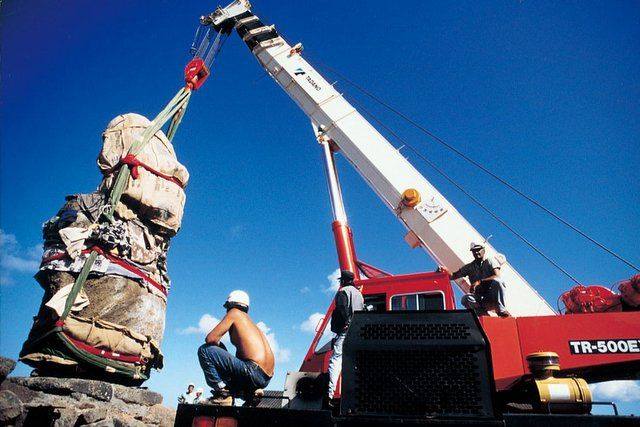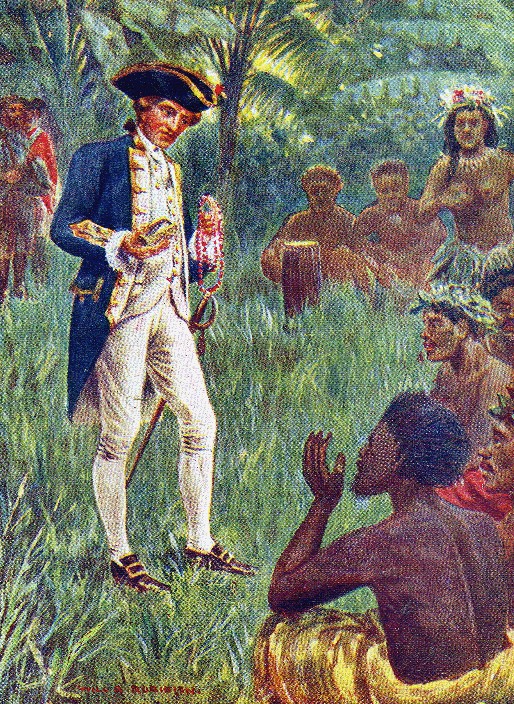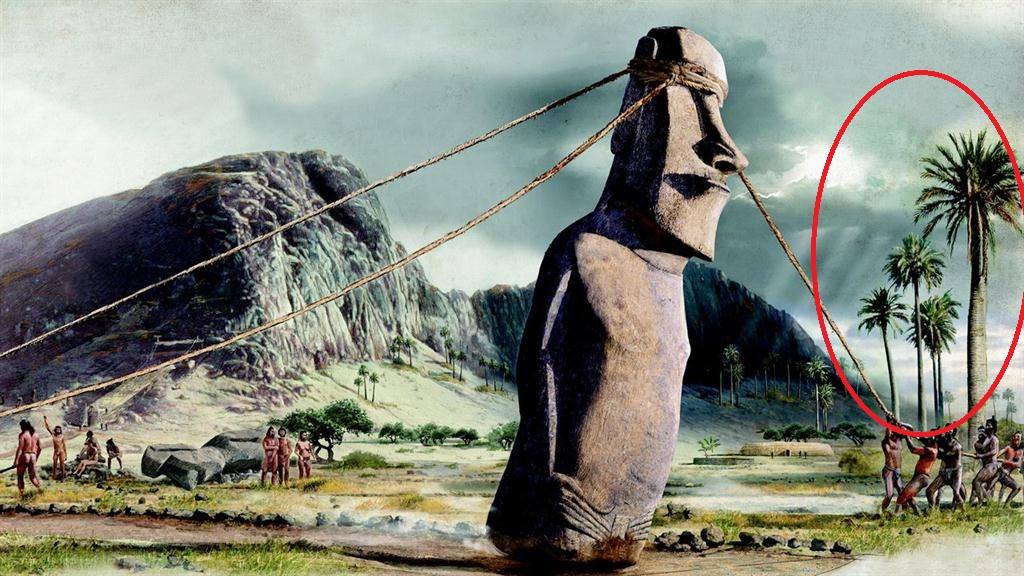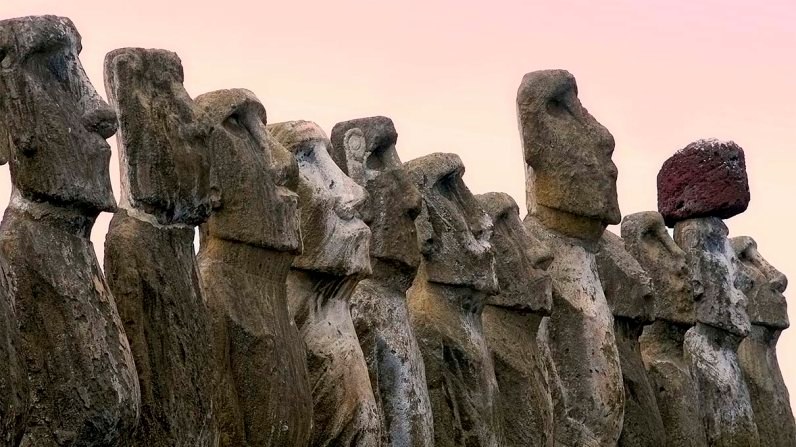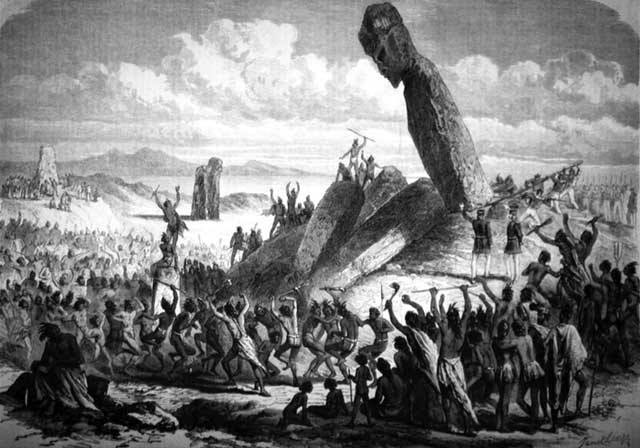Easter Island, a small, isolated island but famous around the world, attracts hundreds of thousands of tourists every year.
There are two things that make this island attractive to tourists: giant stone statues of gods and wooden statues of cannibal demons.
The two extremes of romance and tragedy make the island attract those who love scenery and adventure.
Let’s learn about the mysteries and horrors on the island called Easter.

On Easter day in 1722, while floating in the middle of the Pacific Ocean, the fleet of Dutch explorer Jacob Roggeveen discovered a barren, poor island 3,500km off the coast of Chile.
In his diary, he described the island as being covered with sand and made barren.
At that time, Jacob did not know that he had just found the most remote and strange island in the world.
When he stepped onto the island, Jacob saw that the island was very flat, with only grass and bushes.
Here he came into contact with the aborigines who were still in the Stone Age. There are about 3,000 people struggling to live on the island.
What shocked him was that there were many giant monolithic stone statues lying around on the island.
Aboriginal people call them moai. The moai are from 4 to 20 meters high, weighing from several dozen to hundreds of tons.
There are nearly 1,000 such moai across the island.
Most of the moai were carved from an extinct volcano on the east side of the island.
In the crater, there are still traces of hundreds of statues that are unfinished or have been completed but have not yet been moved.
Among them is an unfinished statue that is as tall as a 5-story building and weighs 210 tons.
From this mountain mouth, super-long, super-heavy statues were transported throughout the island and placed on much larger stone pedestals called ahu.
These stone pedestals are assembled from tens of tons of rocks.
The smallest pedestal is assembled from 300 tons of stone, while the largest pedestal called ahu tongariki weighs up to 9,000 tons.
In 1994, professor Claudio Cristino used cranes with a lifting capacity of 55 tons to rebuild 15 statues standing on ahu Tongariki.
Even though he had a lot of support equipment, he still encountered difficulties because the largest statue named Paro weighed 88 tons.
Is it true that the island’s natives created these structures?
Captain James Cook’s report to the island in 1774 described the islanders as small, skinny, shy and pitiful.
They have fragmented fields growing sweet potatoes, taro, bananas, and sugarcane. The only livestock are chickens.
Fresh water resources on the island are also scarce, people have to work very hard to get enough water to use.
On the island there are only a few bushes, the largest tree is less than 3 meters tall and its trunk is very soft.
The nearest inhabited place is more than 2000 km away by sea.
On an island with no cranes, no carts, no metal, no wood, no draft animals, with only a small group of people, who built these wonders?
That question makes researchers feel confused.
The scientific community is divided into two camps. One side believes that only supernatural forces like aliens can do this.
The other side believes that it was the indigenous people who built these wonders.
But how do aboriginal people do it??
Some researchers have tried using human strength to drag the statue on the ground.
Others tried the method of shaking the statue like a tumbler.
But all the methods are too laborious, while the movement speed is very slow, cannot be applied to the largest statues and can break them.
WOOD IS REQUIRED
People can think of more ways, but wood is required, while on the bare island there are only bushes. If the natives built the statues, how did they do it?
In fact, the natives there also tried and failed.
In 1983, botanist John Flenley made a key discovery. In a cave on the island, his friend discovered fossils of tree seeds.
After analysis, he realized that it was the seed of a giant palm. Clues have appeared, by finding fossils buried at the foot of Mount Terevaka, archaeologists have found fossil palm trunks up to 2.1 meters in diameter, larger than all existing palm species on the planet. world.
Archaeologist Catherine Oliarc investigated by digging through piles of ancient Aboriginal trash on the island to find coal ash. The deeper she dug, the more charcoal she found from woody plants. There are many tree species that can grow up to 30 meters tall. Their wood can be used to make houses or boats very well.
Evidence shows that Easter Island was once a dense forest in the middle of the sea.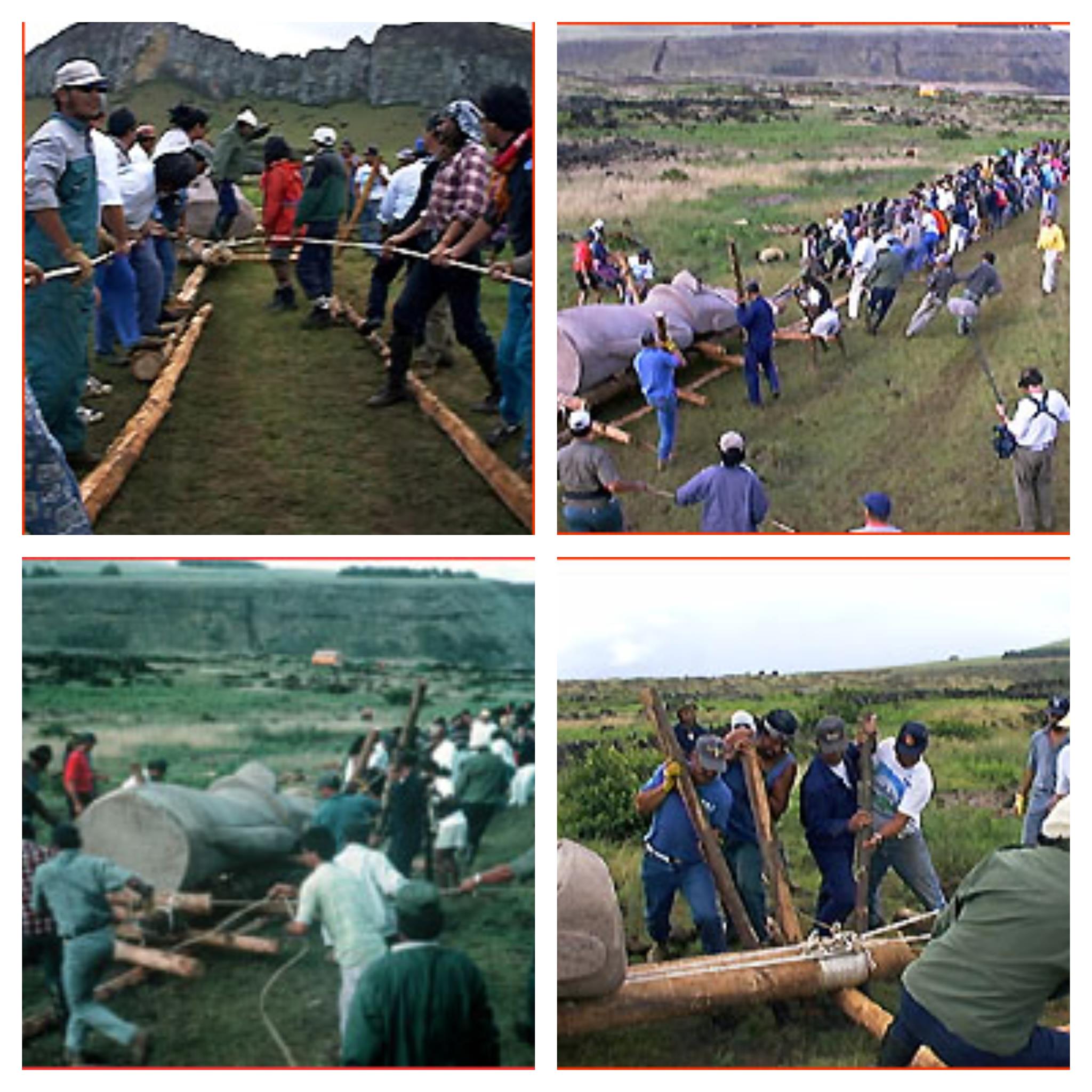
So with an island full of wood, how did the natives move the statue?
In 1998, archaeologist Jo Anne Van Tilburg proposed a plan to use wood as a slide to move a 13-ton concrete replica. With 70 workers, she was able to move the statue 15 km in a week.
According to her calculations, if using 500 workers, it is possible to move and erect a statue called paro weighing 88 tons.
So the conundrum was solved, but that’s when archaeologists discovered they were approaching a DARK part of the island’s history.
By arranging the dates, scientists found that the period of the giant Moai ended suddenly around the 1620s.
And from then on, the islanders began to make small wooden moai, depicting people with white eyes, haggard faces, bared teeth, ribs and spines protruding. That is Moai Kavakava, the man-eating demon.
Perhaps nowhere are cannibals as dense as in Easter Island folklore.
The next question is why did the natives stop erecting giant stone statues praising nobles and switch to making wooden statues of man-eating demons?
The answer can be found in scientific calculations.
Professor Jo Anne Van Tilburg’s husband is an architect who specializes in working with cranes and elevators.
After careful calculation, he realized that it would take the islanders 300 years of hard work to create these works. Each project requires dozens of carvers and hundreds of transportation workers, working for months and years.
The islanders will have to ensure food and wages for hard workers, compensation for injured workers, and lavish parties to inaugurate new statues.
More food means more hunting and more deforestation for farmland.
Not to mention, building statues requires a lot of wood to make tools and fuel.
The more the demand for monuments increases, the more people have to destroy more forests, hunt more meat… putting great pressure on the island’s resources.
So why does it take so much effort and food for these statues? What is the purpose of creating these statues?
According to the natives, the statues represent the economic potential of the tribe
and the power of the nobles.
Instead of war, tribes competed with each other over monuments.
That is why the size of the statues later becomes larger and more elaborate.
When the last statues were erected, the island’s resources reached their limit…
Ancient garbage piles once again tell us tragic stories.
In the deepest soil layers, people find bones of dolphins, seals, dozens of extinct bird species,
ocean fish, large snails, large lizards, sea turtles and ashes of giant trees. giant.
Sure, but the first inhabitants of Easter Island had a prosperous and happy life like in paradise. The closer to the ground, the bones of large and fleshy animals gradually disappear.
Instead, there are a few bones of smaller species such as black snails, chickens, mice, and coastal fish. The ash of large trees also gradually decreases and is replaced by grasses and bushes.
What does this change reflect?
It can be affirmed that the large forests have disappeared, leaving only grasslands. There is no longer any wood to transport statues, to make fishing or heating, there are no more meat-rich animals, the land is no longer productive for agriculture, and groundwater is drying up.
Meanwhile, the population on the island is increasingly crowded.
THE AGE OF GIANT MOAIS ENDS Famine
was evident and the natives began to seek out a very available but previously overlooked food source: human flesh.
In the layers of trash near the surface, archaeologists found human bones with clear marks of sawing, splitting, and cooking to extract the marrow.
The decline turned into a war for water and fresh meat.
In the north of the island, there is a cave called Ana Kai Tangata which means cannibal cave. This is a tribe’s shelter during war. Whenever they win, this tribe often brings prisoners back here to eat and take revenge.
The horror of cannibalism during the famine seasons
is deeply ingrained in the island’s culture, expressed in folk tales
and art forms such as kava kava statues
The island was caught in a spiral of violence.
Many folk tales describe the toppling of opposing tribes’ monuments.
It eventually ended in a major rebellion, when the poor rose up and overthrew all the moai of the nobility.
The age of giant moai is officially over….
That’s why when Jacob Roggeveen stepped onto the island, Easter was just a dry land with pitiful little people, living on rare rains, a few barren fields and stone chicken coops.
But that’s not the worst.
European explorers were also invaders and slave traders. They gave the island’s natives a taste of gunpowder and infectious disease. Thousands were enslaved, thousands more died of smallpox.
By 1872, there were only 111 indigenous people left on the island. Most of the people who understood Aboriginal culture have died.
By 1888, Chile annexed the island, suppressing all rebellions.
The indigenous people were subjected to heavy racism.
It was not until 1966 that they obtained Chilean citizenship.
IT’S ALL GONE…
Today, Easter Island has been recognized by Unesco as a World Heritage Site.
The government here must find a way to limit the number of tourists to 100,000 people per year to preserve the remaining cultural values and reforest the island.
I’m wondering: When the last tree was cut down, what did the natives on the island think?
Hopefully after reading this article, it can help someone answer many of their own questions.


